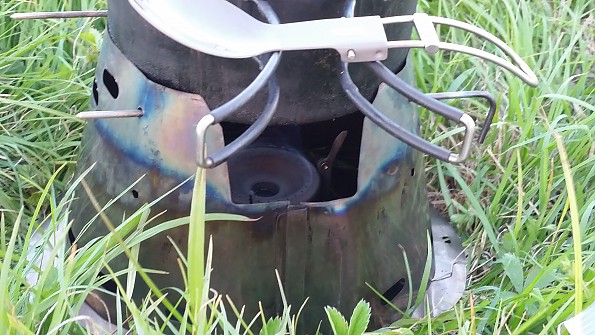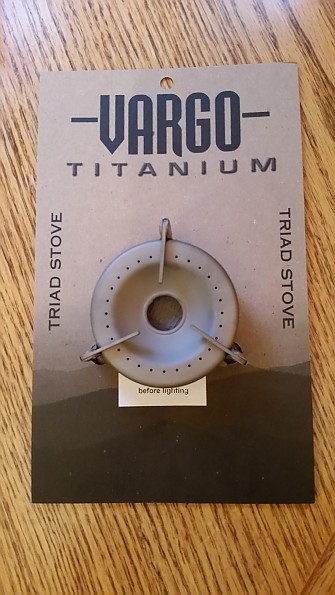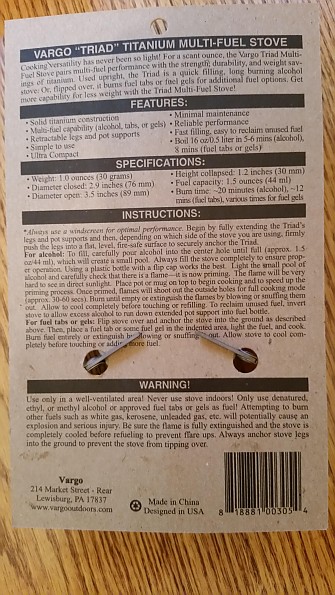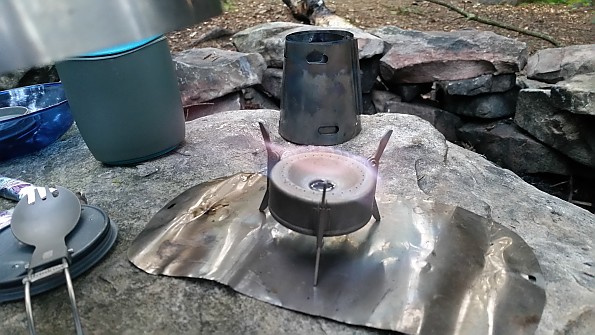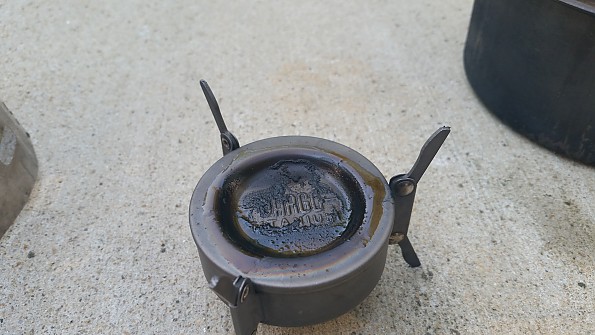Vargo Triad Multi-Fuel Stove
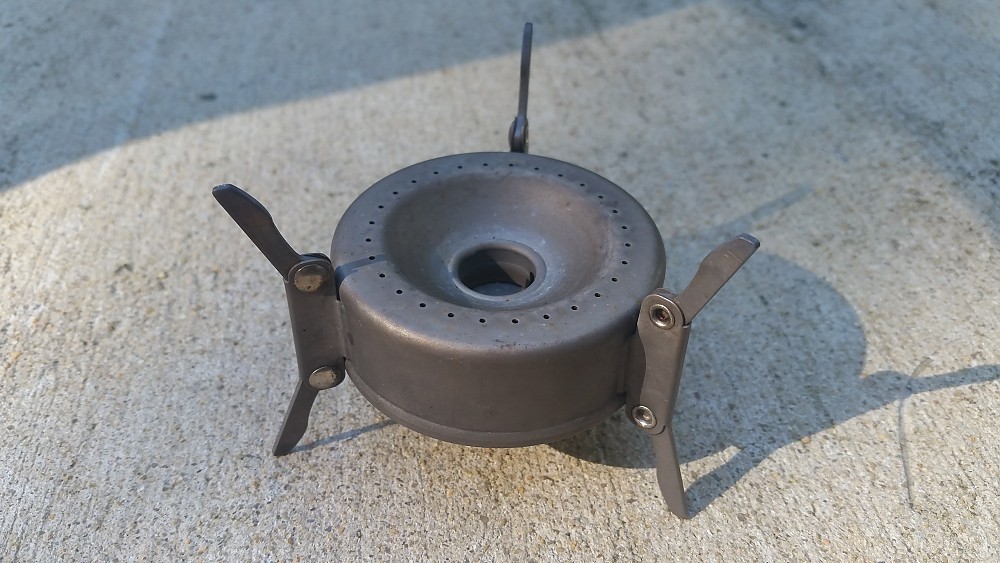
The 2017 Vargo Triad is a very sturdy and functional alcohol/solid fuel stove that I will continue to use due to its bomb proof design and consistent alcohol burn times. It has some inconveniences with the need to use at least 1.5 ounces of fuel and difficulty in recovering leftover alcohol, so may not be the best option for boil in bag solo hikers, but works well for two people and other cooking styles who want the flexibility of using multiple fuel types depending on conditions.
Pros
- Sturdy construction
- Fuel efficient
- Long burn time
- Consistent alcohol boil time
- Adapts to fuel tabs and gels
- Easy to refuel
- Compact storage
- Light weight
Cons
- Needs 1.5 oz alcohol to bloom
- Fuel recovery finicky
- Best to fill with flip top alcohol bottle
- Some more efficient options for solo cooking
- Can retain some fuel
Note that this is a review of the 2017 Vargo Triad model, which is a multi-fuel (alcohol and solid tab/gel) stove - please refer to the 2003 model for the previous alcohol only version of this stove.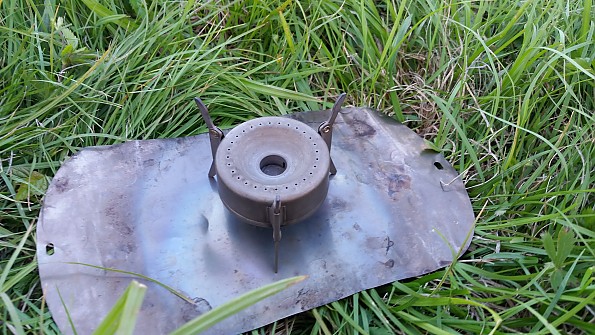
I think any review needs context of the use and testing the gear was put through, and this is especially true of stoves due to the variety of approaches one can take to preparing meals on the trail.
For the last few years, I have enjoyed the flexibility of my Trail Designs Sidewinder Ti Tri with Inferno for wood, alcohol, and solid tab fuel options. I tend to cook about 50 percent of my meals by just boiling water and the other half cooking and simmering soups, stews, or pasta.
With all the fantastic pre-packaged dehydrated meal options available now, I sometimes wonder why I still bother to simmer cook my own but there is something in that process that makes me very satisfied and I relish the “simmer time” when I can smell dinner cooking while I contemplate life (i.e. have a staring contest with a squirrel or take notes on my day’s travels).
I usually use my Sidewinder stove for every breakfast and dinner, about half my lunches, and every other day or so an afternoon tea in the colder seasons. Sometimes at dinner or breakfast I will cook twice—coffee at first on a slow starting morning followed by cheese grits with chiles (cooked for 5+ minutes) or a boil in bag breakfast. Arriving at camp early some days, I’ll often heat a cup of soup, tea, or coffee, and follow that an hour or two later with dinner.
Primary fuel for me is a handful of twigs in the evening on the Sidewinder except during monsoons or above treeline, but alcohol many mornings and most hot lunches so the cool down time is quicker and there is less clean up.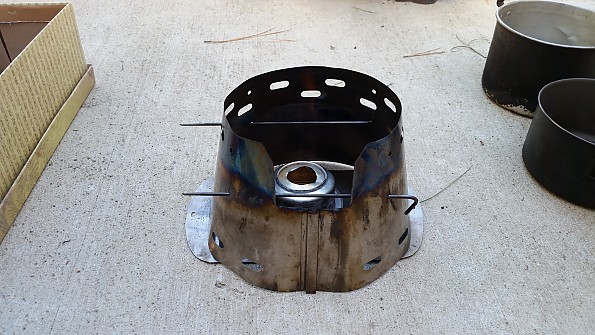
The Sidewinder came with a 12-10 alcohol stove (pictured above - basically Trail Design's version of a pop can stove) and it worked as well as any other option I tried. However, after two near disasters almost crushing the stove (including one trip where I had to “rebuild” a crushed side of the stove) I decided I wanted to upgrade the system and get something “bombproof” that would fit into my existing Sidewinder cooking system.
Since I had some other Vargo gear and it is all pretty much indestructible, I decided to splurge on the newly re-designed 2017 Vargo Triad. Beyond the construction, I liked the multi-fuel option although I rarely use Esbit tabs except with the built-in pot stands/legs for day hike lunches and coffee/tea breaks with a small windscreen. My pack always has a couple of tabs in case I lose all my alcohol or get caught in a downpour.
Product Description & Specifications:
As always, I appreciate a piece of gear even more when it starts with simple packaging and clear instructions. Vargo Outdoors excels in this with most of their products being placed simply on a piece of recyclable cardboard with instructions right on the back.
The Vargo Triad Multi Fuel stove is an upgrade this year (2017) of the original Triad stove (2003 model). The extendable legs can be used as stove supports or pot stands, and the stove can be flipped from an alcohol burning side to solid fuel bottom with indented area. The 2003 version only provided for alcohol burning, which is why this review is in a separate category as a multi-fuel stove.

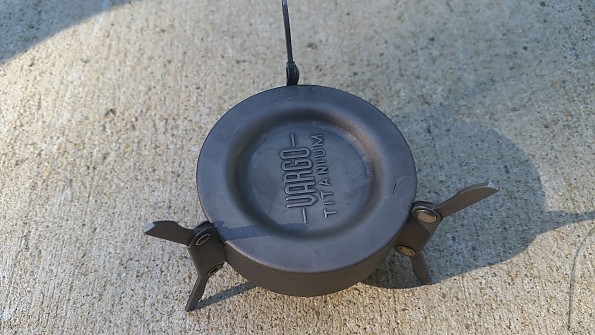 The entire stove is constructed of titanium, with the exception of what looks like steel rivets in the legs.
The entire stove is constructed of titanium, with the exception of what looks like steel rivets in the legs.
Vargo Outdoors provides the following specifications:
- Weight: 1.0 ounce (30 grams)
- Diameter closed: 2.9 inches (76 mm)
- Diameter open: 3.5 inches (89 mm)
- Height collapsed: 1.2 inches (30 mm)
- Fuel capacity (alcohol): 1.5 ounces (44 ml)
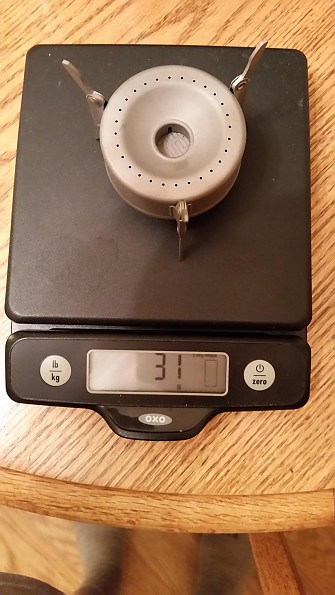 All these specifications were so close to my measurements that I want to give Vargo Outdoors great credit for honesty and accuracy. The only differences I found were 1 gram (!) higher weight that may be due to my scale.
All these specifications were so close to my measurements that I want to give Vargo Outdoors great credit for honesty and accuracy. The only differences I found were 1 gram (!) higher weight that may be due to my scale.
2003 vs 2017 Design
Vargo explains the 2003 to 2017 model re-design as mainly a 450% increase in fuel fill port diameter, and adding an indented bottom to hold solid fuel tablets like Esbit or gels. These improvements were made while maintaining the light weight (1 ounce) and durable construction. Basically, the Triad is now a multi-fuel stove that improves on the original Triad design and adds a solid fuel option eliminating the Triad XE multi-fuel stove from their lineup.
Here is the stock photo from Vargo Outdoors – 2017 model on left and 2003 model on right. You can see the much larger fill port on the 2017 model.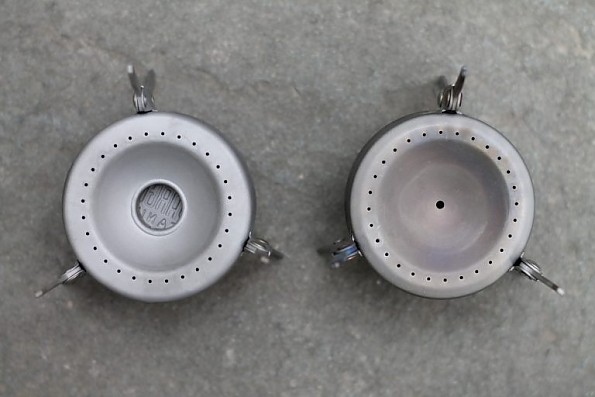
Another stock Vargo photo showing the bottom of the two models. You can easily see the indentation to hold the solid fuel tabs or gels on the 2017 model.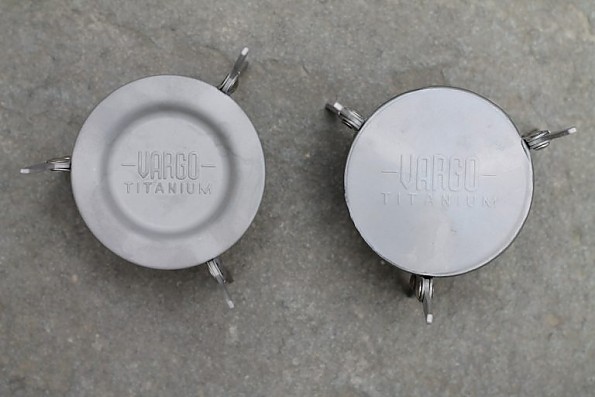
Vargo Claims:
Here are the claims Vargo makes about the Triad, along with my own opinion on how they hold up. Further details are provided in the narrative of the review below.
- Solid titanium construction for extra durability - Yes
- Multi-fuel capability for added versatility - Yes
- All-season, all-terrain usability - Yes
- Folding legs and pot supports - Yes
- Simple to use - Yes – except for fuel recovery which takes practice
- Ultra-compact - Yes
- Minimal maintenance required - Yes
- Reliable all-season performance - Yes – no snow tests yet due to mild winter
- Enlarged filling hole for faster fueling - Yes
- Easy to reclaim unused fuel - No – takes practice and often drips
- Boils 16 oz/0.5 L in 5-6 mins (alcohol) - Yes – but up to 8 min when cold/windy
- Boils 7-8 mins (fuel tabs or gels) - Maybe – seems to take 10-12 min for tabs
- Burn time ~20 mins (alcohol) - Yes
- Burn time ~12 mins (fuel tabs) - Yes – actually can be up to 20 minutes
Testing:
I tested this stove from January 2017 to August 2017 over six multi-night trips. I used the Triad for approximately 30 meals including breakfast, some soup lunches, tea breaks in the afternoon, and some dinners. Conditions during the testing ranged from below 10 degrees with sustained 20 mph winds to over 80 degrees. Wind speeds got up to 30 mph in unsheltered camps and rain included several downpours lasting 30 minutes to 12 hours.
I used the Triad primarily as an alcohol stove because that is my preferred option, but made sure to test several Esbit tabs as well, both on the trail and in my “test lab” (OK – the back yard, but I do have a campsite and fire ring there!). The lab tests were conducted in varied wind, rain, and temperatures when I had a chance for more controlled “science” including measured amounts of water and stopwatch for timing.
Design, Construction & Durability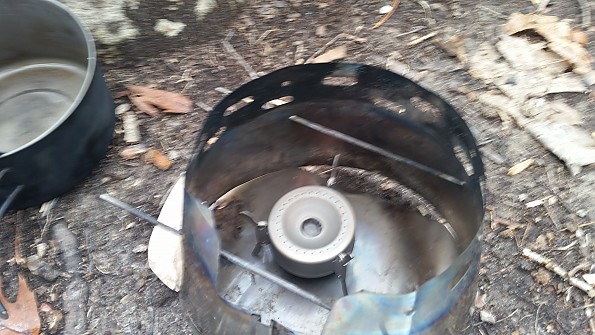
Vargo claims that the Triad has a simple design, and I agree. There are no moving parts except for the extendable legs/pot stands which function as either depending on your use of alcohol or solid fuel. As with most Vargo products, the Triad is constructed entirely out of titanium and well made.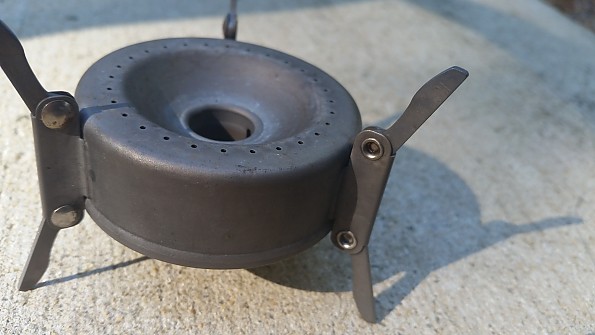 The rivets on the legs show no signs of wear or weakness and extending or retracting them has not changed at all since I purchased the stove. Movement of the legs is fluid without being loose so there is no worry about collapse.
The rivets on the legs show no signs of wear or weakness and extending or retracting them has not changed at all since I purchased the stove. Movement of the legs is fluid without being loose so there is no worry about collapse.
The legs and/or pot stands are not only sturdy but spaced out so that it provides a good base if sunk into the ground or placed on a flat surface. Vargo Outdoors recommends a base width of 90 mm for the pot stand. I haven’t tested this much, but the few times I have rested my 1.3 liter pot directly on the stand it has been very stable.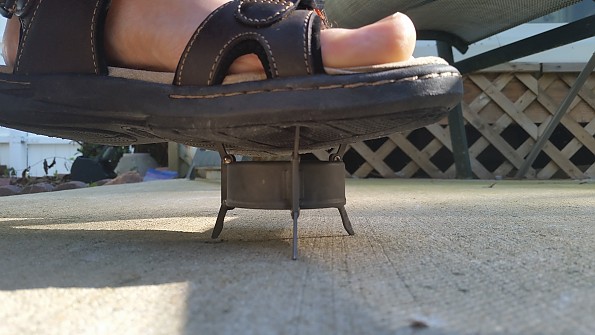
One of my main criteria for this purchase was Vargo’s reputation for building sturdy titanium gear. I have several of their products and have been happy with the construction and durability of each of them. Therefore, I had little reservation to test the Triad by putting a lot of my weight on it.
Note I didn’t put all my weight on it in the photo above as I am no ballerina and probably would have fallen over! As you can see from the indentation in the bottom of a pair of tough soled sandals, I put a good bit of weight on the Triad and the only give came from the concrete of my patio which got scraped a little.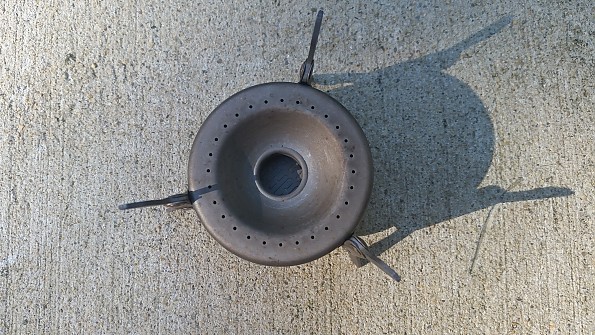
I really like the new design (although I did not own the prior version) as filling the Triad in the generous port is easy, especially with a flip top fuel bottle, but even with a regular it just takes a little care not to spill and fills quickly.
The only drawback I could pick out in the Triad design is that it is so small and light when folded up, that I occasionally threw it into an outside pocket of my pack and had trouble finding it later! Here is a photo of the Triad folded up alongside a small set of keys for scale.
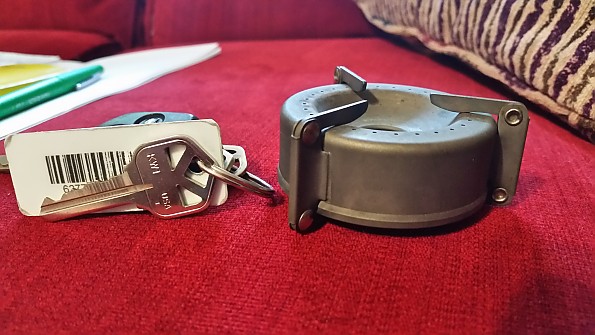 Overall, the Triad meets my high standard for durability, and you can apply the overused “bombproof” term if you want as it really seems true in this case.
Overall, the Triad meets my high standard for durability, and you can apply the overused “bombproof” term if you want as it really seems true in this case.
Ease of Use
As mentioned above, the improved Triad design makes it easy to fill with a 450% increase in the fill port in the center of the stove. Setup is extremely easy as the legs can be quickly extended. If you are not in a flat area or using a base like the one shown below, a firm push sets the legs into the ground to create a stable platform.
The resulting large pool of alcohol in the fill port is extremely easy to light and blooms efficiently if instructions are followed (put the pot on and use a windscreen). When not using the whole fuel dose, I found it easy to blow out the flame with one quick breath most of the time.
I definitely prefer a flip top lid fuel bottle to fill the Triad. The first few trips I used a standard fuel bottle with little issue but I had to take care not to spill it. On winter/cold trips I carry a 2 ounce flip top bottle in my pocket to keep the fuel warm (a real key to winter operation of an alcohol stove), and now on all trips I carry the Vargo Fuel Bottle (see great review by Bentbrook).
The fuel recovery works well if you just have a dribble remaining. I seemed to recover everything except a dash that remains in the stove but dries out quickly. However, if there is significant fuel left, which will often occur if you have to prime with 1.5 ounces and you only want to boil water, you have to be extremely careful and quick to re-pour it into the fuel bottle. I have tried to show this in the videos below.
First, a simple recovery of a minor amount of fuel:
Second, recovery of a larger amount of fuel with a "perfect" pour:
And finally, a common mistake of pouring too slowly with a large amount of fuel:
You must watch that the lower leg is elevated quickly above the upper leg or you briefly lose fuel in both directions which is obviously inefficient. With a significant excess it also pours out of multiple flame ports so is tougher to get to pour down the “spout” or leg.
It took me a good bit of practice to get this right and not lose any fuel, and obviously didn’t get it right in the last video (although I was trying to film at the same time!). I often lose a little bit in this finicky process, but not enough over a shorter trip to cost me a significant amount of fuel (i.e. reduce the number of meals). I don’t feel it’s just me, as even the video on the Vargo Outdoors website shows a little bit of fuel loss when pouring.
While the fuel recovery works once you practice it a bit and therefore only reduces fuel efficiency by a drop or so per recovery, many folks may not like to hassle with it. I can see it being an issue if you depend solely on alcohol or for longer trips when you begin to run out of fuel before resupply. If you are a no muss-no fuss boil water person, I would consider first if you will want to play around with fuel recovery!
On trips with my lovely wife, I found the Triad excellent as we needed additional fuel to cook more food for the two of us, so fuel recovery wasn’t really an issue.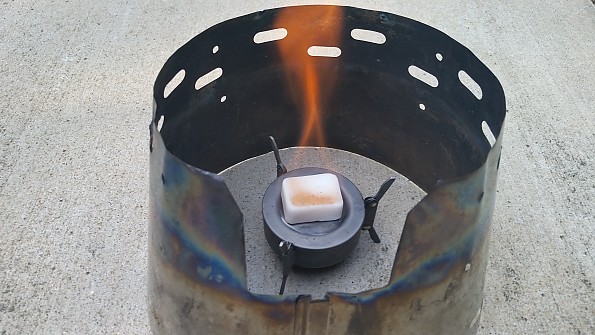
Esbit tabs, which I used only a handful of times for testing purposes mostly, seemed to be less efficient than what Vargo claims. However, due to my limited experience with this fuel type, I may have not been using them as efficiently, and they seemed to work as well as other times I have dabbled into solid tabs (in other words variable depending on orientation and weather conditions) even with dedicated graham cracker fuel tab stoves.
Since this is a multi-fuel stove, there is some potential for loss of efficiency over a graham cracker version that projects heat more directly with sides on the tabs. Let's face it, multi-purpose gear often suffers slightly when compared to one function items, so it's a choice you have to consider.
The residue left on the bottom of the stove from an Esbit tab is of no consequence to me as that is typical of any solid fuel tab stove and doesn’t add any noticeable weight. The few times I have cared to clean it, the excess comes off easily and since the Triad is so well constructed you can scrub till the cows come home and not damage it!
Fuel Efficiency & Performance
Ignoring the initial amount of fuel needed and recovery, I found the Triad to consume alcohol at a similar fuel rate to other alcohol stoves.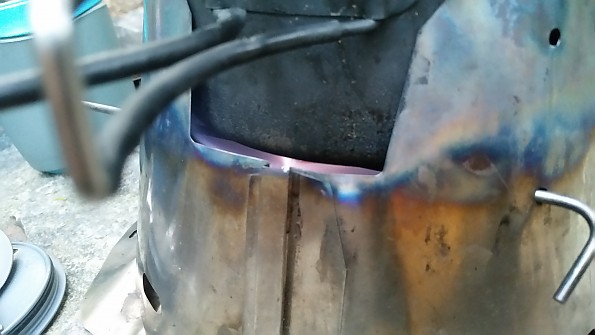
Boil and burn times were similar to other stoves I have tried and are detailed below. The bloomed flame works well with my Sidewinder stove and seems to provide heat across the entire bottom of the pot as you can barely see in the photo above.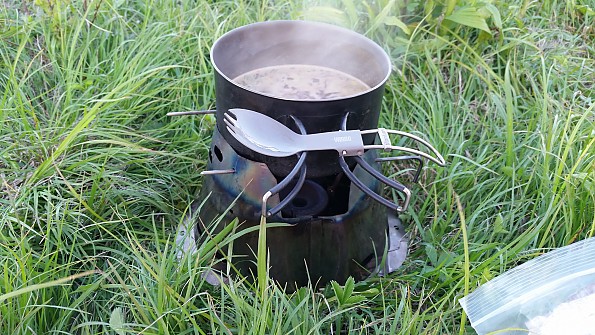
I found the Triad excellent for simmering meals if you have the right setup to put the pot at the right height. The photo above shows my Sidewinder set at wood burning height. With the Triad legs extended I can simmer almost perfectly without burning the pot or my dinner! You may also be able to do this with a lower pot stand by not extending the legs of the stove, but I didn’t try that except as a test at home where it worked well.
As mentioned, I tested the Triad several times in my back yard “test lab”. I didn’t take great notes on many of the trail tests but got down to some real “science” on multiple trials.
Here is a sample of the results:
Test 1
Fuel: Alcohol
Temp: 45°C
Wind/Rain: Light
Water: 2 cups
Boil Time: 7 min
Burn Time (min): 20 min
Test 2
Fuel: Alcohol
Temp: 40°C
Wind/Rain: None
Water: 1 cup
Boil Time: 5 min
Burn Time: 20 min
Test 3
Fuel: Alcohol
Temp: 50°C
Wind/Rain: Drizzle
Water: 2 cups
Boil Time: 8 min
Burn Time: 20+min
Test 4
Fuel: Esbit
Temp: 70°C
Wind/Rain: None
Water: 2 cups
Boil Time: 12 min
Burn Time: 20 min
The key to the alcohol boil time is the bloom of the stove. When I used, per the instructions, approximately 1.5 ounces of alcohol, the bloom without any other priming occurred within two minutes and boil times were close or equal to those advertised and slightly longer in colder weather. I tested the bloom time with 1 ounce of fuel and it took over 5 minutes to reach full flame and a lot longer to boil obviously.
In windy conditions both alcohol and fuel tab modes stayed lit with little reduction in efficiency, but that factor is an evaluation more of a windscreen set up than the stove itself.
General Thoughts on Performance:
My tests during trips are a lot less on the science side and more notes and musings. Mostly this is due to hunger in the evening or grogginess in the morning! I found the Triad easy to use (except the fuel recovery discussed earlier). It heats really well in the rain and cold…on a windy trip with temperatures down to 10 degrees one night, it cooked efficiently (boiled 2 cups of water in less than 10 minutes) when I was too much of a wimp to get out of my sleeping bag and gather wood. Once warmed up with dinner inside me, I did gather twig fuel and therefore didn’t test out the alcohol when it was below 10 the next morning as I wanted the fire to heat me up!
No matter what conditions I tested the Triad, I found very consistent alcohol boil times in my Sidewinder system. Boil times for 2 cups (a typical meal amount) ranged from 5 to 8 minutes. I must note again, that this assumes an efficient bloom by using 1.5 ounces of fuel and having the windscreen and pot placed immediately on the stove.
Note that ALL alcohol stoves should be used with a windscreen unless specifically instructed not to, and therefore this should apply to most windscreen setups unless they are inefficient.
The alcohol burn time always ran up past 20 minutes in various weather conditions. This allowed me to fully simmer my home cooked meals several times by raising the Sidewinder supports to the wood burning level and allowing more space from the alcohol flame, something I also did with my 12-10 stove.
The biggest issue with the Triad is the need to use more initial fuel than other alcohol stove alternatives. Due to my approach of wood burning (reducing my dependence on alcohol fuel) and simmering longer with the alcohol (as I don’t have to carry as much fuel or worry about it) I didn’t find this to be a major drawback. However, it may be a big issue for gram counters and boil-in-bag cooks that want full fuel efficiency and limited fuss at meal times.
Conclusions
I struggled a bit with the rating for this stove. If I rated it just for my own use it would be 4 to 4.5 stars as I don’t often need to recover fuel due to my cooking style. However, I felt I had to rate it for a more general audience with a variety of cooking styles in mind including primarily boil in the bag folks.
If you want a “bomb proof” alcohol stove that can also handle fuel tabs, the new 2017 Vargo Triad should be on your list of options to consider. While there are a few improvements I would like such as less finicky fuel recovery or the ability to prime with only 1 ounce or less of alcohol, overall I am pleased with the stove and will continue to use it. There are some other options out there that can perform equally well or better with slightly less alcohol fuel, but the Triad meets my standard of toughness and fits with my boil then simmer approach as I often use 1.5 ounces each meal anyway.
However, if you are a boil-in-the-bag person and/or gram counter on the fuel side you will probably want to stick with a stove that requires less initial fuel so you don’t have to mess with the finicky recovery. If you cook longer or for two people and want a flexible stove then I would recommend the Vargo Triad as an excellent option.
Source: bought it new
Price Paid: $34.95
Burns fuel, lacking functionality.
Pros
- Small
- Lightweight
- Simple
- Clean
Cons
- Maybe too simple
- Small
Got er about 2 years ago. Used couple dozen times as secondary stove to mainline MSR Dragonfly (make tea/coffee while dinner/breakfast cooking idea). Realised my GSI outdoors cup is too narrow for the 3 pegs and sat funny/tipping over while brewing. Also did not like the large potfuls of hard earned chow sitting on 3 pegs just threatening to tip over if you but lapsed on your attention once.
So, to the drawing board.
Tools: pencil die grinder with cutoff wheel, grindstone, wire brush. Cobalt drill bits and mad patience. Felt for marking the metal. Got the Jetboil Pot Support and 2 tomato cans. Lopped off all tabs on pot support, created 3 holes (could be slits instead to simplify), enlargened the centre hole and brushed burrs off. Took soup can, made 5 holes for inlet on 1 side (for wind). Cut can short and made slits for Jetboil tabs. Used 2nd can to make tiny lid for secure stowing of fragile parts in wild depths of the overnight bag.
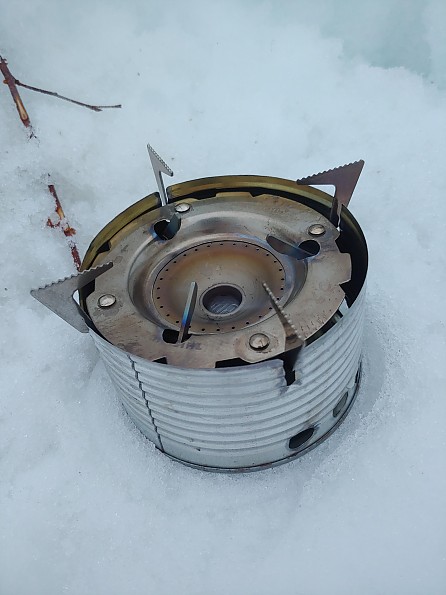
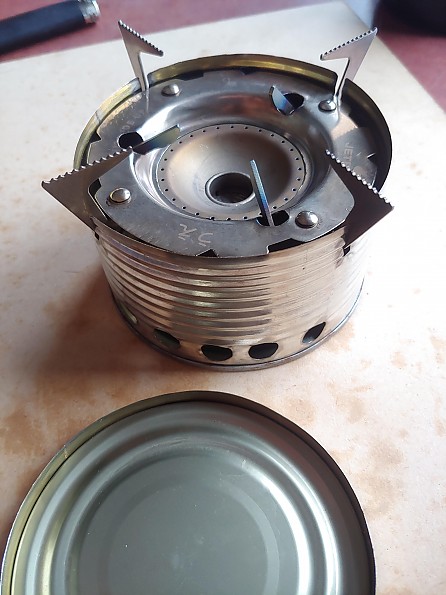
Looks to bloom quick even with the heat sink that the Jetboil happens to be, but the can helps retain its heat so it burns good. I always spill the fuel over/ontop/under the stove for reliable blooming. Never any problems with that yet. Looks to be good to set combo on snow and cook with mild settling.
Vargo Triad is okay unit for what it is, no flaws in construction and should hold up well as long as the user isn't drunk. Not really a stove for cooking large amounts, but it has enough heat for about 4 litres. With the augments it should be more versatile.
Background
Works, needs mods
Source: bought it new
Price Paid: 40-ish
Very good for four-season solo or couple backpacking stove.
Preheat and fuel recovery somewhat annoying, but it would build up with patience and practice. Preheating should be very cautious, unless overheating may result in overwhelming volcanic flame.
Of course windscreen is mandatory and most important factor of stove efficiency, even in no wind.
Suitable for 600~750 titanium cup. Previous version was very difficult, too slippery not to use practically.
Pros
- Sturdy
- 4-Season use
- All in one
- Relatively lightweight and small sized
- Can adopt small diameter pot
Cons
- Preheat
- Fuel recovery
Background
A lot.
Source: bought it new
Price Paid: 30 dollars
Your Review
Where to Buy
You May Like
The Triad Multi-Fuel Stove replaced the Vargo Triad Alcohol Stove as of Fall 2017.
Specs
| Price |
MSRP: $34.95 Current Retail: $34.95 Historic Range: $34.95-$43.99 Reviewers Paid: $30.00-$34.95 |
| Fuel |
alcohol, solid fuel tabs and gels |
| Diameter open |
3.5 in / 89 mm |
| Diameter closed |
2.9 in / 76 mm |
| Height collapsed |
1.2 in / 30 mm |
| Fuel capacity (alcohol) |
1.5 oz / 44 ml |
| Burn time |
~20 mins alcohol, ~12 mins fuel tabs, various for fuel gels |
| Weight |
1 oz / 30 g |


